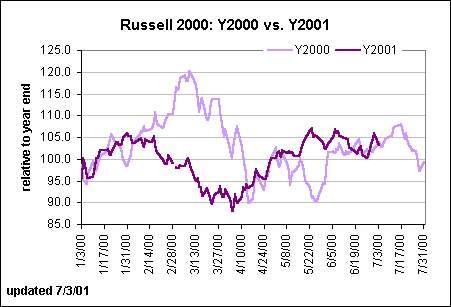Each year, the Frank Russell Company rebalances its U.S. stock indices. The Russell offers a variety of indices including the Russell 1000, the Russell 2000 and the Russell 3000. Each of these can be further subdivided into Value and Growth measures. The Russell Company rebalances its indices annually in order to accurately rank the 3000 largest companies in the U.S. stock market by market capitalization. While investment professionals likely use the range of Russell indices, the financial media regularly reports on the Russell 2000 since it is the best measure of stock prices for small-capitalization companies.
While the Dow Jones Industrials Average sometimes sees new companies in its index of 30 industrials, the changes are few and far between. Standard & Poors also updates its indices, including the commonly known S&P 500. The changes can occur any time during the year and the index will indeed incorporate new companies, remove old companies nearly every quarter. The difference in the Russell indices is that the rebalancing occurs on schedule once a year.
If a component of the Dow is changed, it certainly gets big attention. But often times, the S&P 500 will find new companies added and old companies removed with little warning. The investment managers who "buy the index" must scramble to sell companies that are no longer included and buy the new companies for their portfolios. In contrast, the Russell makes the adjustment once a year and offers investment managers a schedule that reveals preliminary and final information on the additions and deletions to its indices. The bulk of the activity takes place in June, right up to the final day of the month. The final list of companies that make up the Russell 2000 will be available to investors on July 9.
In the year 2000, the Russell 2000 index saw 684 companies added and 451 companies deleted. Companies can be deleted because they are either growing rapidly - and no longer fit the small-cap requirement. In that case, they would be "promoted" to the Russell 1000 index. Companies might also be deleted because they have lost significant market value and new companies have surpassed them in market capitalization.
In 2000, the smallest company's market cap was $177.9 million. The median market cap for the Russell 2000 was $466 million during this time period. This compares with a median market cap of $4.1 billion for the Russell 1000 (of large cap companies). The median market cap for the Russell 2000 has just about doubled since 1995. Growth for large cap companies has grown only slightly faster.
Looking at the Russell 2000
The chart below compares the daily movement in the Russell 2000 for this year and last year. Notice that the Russell took a dive early in 2001 that resembled the plunge, albeit not by the same magnitude, as 2000. Since May, the Russell 2000 has hovered in a tight range. It is one of the few market indices that have actually remained above yearend levels. Based on these two years, it doesn't appear that the rebalancing dramatically skews the Russell 2000. After all, while the addition of new companies would cause their price to rise, it is likely that the deletion of companies would cause their price to fall. This would tend to keep the index from showing excessive growth in the month leading up to its re-balancing.

Evelina M. Tainer, Chief Economist, Econoday
| 